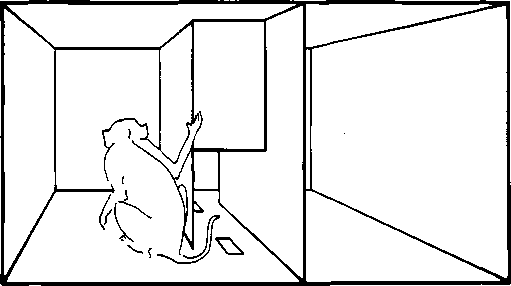Perception, 1978, volume 7, pages 343-348
Effects of red light and loud noise on the rate at which
monkeys sample the sensory environment
Nicholas K Humphrey, Graham R Keeble
Sub-Department of Animal Behaviour, University of Cambridge, Madingley, Cambridge CB3 8AA,
England
Received 5 December 1977, in revised form 27 January 1978
Abstract. Monkeys, given the opportunity to move between two featureless chambers, ‘sample’ first
one, then the other in a way which reflects a Poisson decision process. The rate of sampling is
higher in red light than in blue and in loud noise than in quietness. We suggest that monkeys
‘tune’ their sampling rate to the a priori probability of change in the environment.
1 Introduction
Earlier research on the reactions of monkeys to red and blue light led us to conclude
that “at a behavioural level the most that can safely be said from this series of
experiments is that monkeys ‘do things faster’ in red light than in blue” (Humphrey
and Keeble 1977). The new experiment reported here allows us to be more specific
about what it means to “do things faster”. We found grounds in the earlier
experiments for rejecting any account in terms simply of changes in motor activity
and suggested instead that “this phenomenon may reflect an influence of colour on
the passage of subjective time”. We now believe that the right way to interpret the
monkeys’ behaviour is in terms of the rate at which they attempt to ‘sample’ the
sensory environment. Sampling rate (as defined by this experiment) goes up in red
light as compared to blue. But it is also affected by factors other than colour; for
example it goes up in noisy conditions as compared to quiet ones. We are led to
suggest that monkeys ‘tune’ their sampling rate to the probability of change in their
environment—and that red light is one among several influences which may lead
them to expect more rapid change.
The experiment grew out of a surprising observation. In the course of setting up
an experiment on sensory preference we designed the apparatus shown in figure 1.
The monkeys were given the choice of sitting in one or the other of two chambers
whose illumination and noise levels could be varied. The chambers were connected
by a short tunnel through which the monkeys could pass freely to and fro.

Figure 1.
More intriguing information
1. A Rare Case Of Fallopian Tube Cancer2. The Shepherd Sinfonia
3. 09-01 "Resources, Rules and International Political Economy: The Politics of Development in the WTO"
4. The name is absent
5. The name is absent
6. The name is absent
7. The name is absent
8. The duration of fixed exchange rate regimes
9. Structural Influences on Participation Rates: A Canada-U.S. Comparison
10. The name is absent